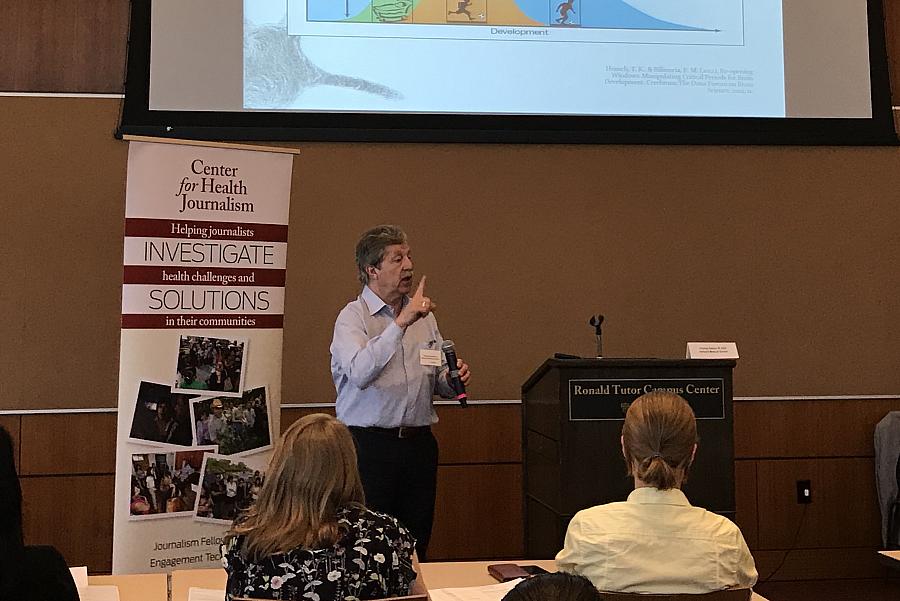A leading researcher on what adversity does to children’s brains has seen this story before

Charles Nelson, a professor of pediatrics and neuroscience at Harvard Medical School, speaks to journalists about how adversity shapes children's brains this week at the 2019 National Fellowship.
(Photo by Chinyere Amobi/CHJ)
There’s a tremendous amount we’re still learning about how the human brain develops. But in recent years, a broad consensus has emerged among leading researchers that high levels of stress, trauma and neglect are kryptonite to budding brains.
It was a point made with lucid rigor by Charles Nelson, a professor of pediatrics and neuroscience at Harvard Medical School, who took journalists at the 2019 National Fellowship on a crash course through decades of pioneering research from him and colleagues showing the life-long mental and physical fallout from adversity, trauma and neglect. It’s a body of research that sounds alarm bells for children everywhere from big-city neighborhoods ravaged by homicides to Appalachian towns devastated by the opioid crisis to the detention facilities holding migrant children along the border.
Nelson has a uniquely powerful vantage on how horrible conditions deform young brains: He is one of the lead researchers of a now-famous randomized controlled study of Romanian orphans living in institutions and foster homes. His team has tracked 136 kids since 1999, with half placed in high-quality foster care with families and the other half remaining in institutional care. They found over time that the children who stayed in institutions had less white and gray brain matter, less brain activity and connections, lower IQs and diminished executive function, the part of the brain that helps regulate emotions and plan for the future. Kids placed in institutions before age 2 had worse brain outcomes that children placed after 2, while children placed with foster families had far better outcomes on all these measures.
“Chronic exposure to stress without a buffering relationship can lead to long-term changes in the brain,” Nelson said.
When the researchers held a press conference in Romania to share their stark findings after two years of research, the government promptly changed the law, barring children from under 2 from being institutionalized and launching a government-run foster care program. The country began shutting down its orphanages, and UNICEF has since used Nelson’s research to persuade other countries to stop putting kids in similar institutions.
But it’s not only profound neglect in a Romanian orphanage that can lead to diminishments in brain function. Nelson is also conducting research funded by the Gates Foundation in Bangladesh that has found children from families that rank lower on measures of caregiving show weaker responses to basic visual stimuli when they’re hooked up to brain electrodes. In Boston and Los Angeles, Nelson and his collaborators have found that the more stress a mom reports, the less measurable brain activity in their 2-month-old babies.
These and similar findings have led Nelson and some of his fellow researchers to voice grave concerns about the children separated from their families and detained in facilities at the U.S. border under the Trump administration. Based on accounts from journalists and foundation representatives, Nelson said he sees a lot of parallels between the children in the detention facilities and those he’s spent his career tracking in Romania. While he’s careful to qualify his observations by pointing out that much depends on the length of the separation, the child’s age and what happened in the journey leading up to that point (were family members being threatened with murder in their Central American hometown, for instance?), Nelson says we can expect to see children emerge from the detention experience with mood disturbances, acting-out behaviors and eventually, post-traumatic stress disorders. Parents are likely to suffer stress-related illnesses, mood disorders and, in some cases, a deeply sundered relationship with their child.
The parallels propelled Nelson and his colleague Margaret Sheridan, a psychologist and neuroscientist at the University of North Carolina, Chapel Hill, to pen an op-ed in The New York Times last year titled, “How to Turn Children Into Criminals.” Said Nelson: “We did not pick this title to be inflammatory — we picked it based on data.”
That data comes from the Romanian studies, where the children kept in institutions were 11 times more likely to show a lack of empathy and guilt, which are traits commonly associated with criminal behavior, than the kids placed in foster care. “What we find is a very high rate of callous, unemotional traits (in children), particularly among boys, who have been in an institution,” Nelson said.
He also points out that it’s not just the trauma of children separated their family and warehoused in facilities that poses a risk for long-term psychological damage. “For older kids in these detention centers, the likelihood of abuse going on — either perpetrated by other kids or the staff — is very high.”
“The bottom line is that we should learn from the science,” Nelson said.
In a refreshing instance of powerful research fast reshaping policy, the Romanian government did heed the science. Meanwhile, the story of detained children in the United States is still unfolding.

